Hi! My name is Trish Riswick. I’m a Team Lead on our Social team here at Hootsuite, and I’m here to tell you exactly how to build a social media calendar that will support your goals and keep you organized.
Our social media calendar is the backbone behind all the content marketing you see on Hootsuite’s channels. I hate to break the spell of real-time spontaneity, but every post is meticulously planned in our social media content calendar before it’s even created.
I’d be lying if I said planning a content calendar for our audience of over nine million (!!!) people across eight social media platforms is easy. But it’s important, and can even be fun.
I’ll take you through how we plan our content calendar at Hootsuite and share some tips for success. Our process isn’t the only way to make a social calendar, but I hope seeing it inspires you to create one that works for you.
PS: If you’re just here for the free template, you can grab it here. No email required!
Key Takeaways
- A social media calendar is your roadmap for planning and organizing all upcoming content, including post dates, times, hashtags, images, and links. It can take any format that works for your marketing team: a document, an Excel spreadsheet, or dashboard in your project management tool.
- A calendar brings structure to your content strategy, helps you stay aligned with larger marketing goals, and can draw your attention to content gaps. No more last-minute scrambles for content or rushing the design team for graphics—you’re prepared!
- When building a social media calendar, start with a solid strategy, then plan your posting schedule (we recommend a weekly planning cadence). Use social media scheduling tools like Hootsuite, Wrike, and Miro for brainstorming, creating, and scheduling content.
A social media calendar is a strategic plan of all upcoming content, including the date and time posts will go out and supporting information, such as links, hashtags, images or videos, mentions, Reels audio, or other platform-specific features.
A social media calendar can be a document, a spreadsheet (we have a free social media calendar template for you here!), or part of your project management app—whatever works for your team.

Organizes your work
A social media calendar lets you streamline the visual structure of your content. At a glance, you get a bird’s eye view to ensure you’re sticking to a consistent publishing schedule.

Aligns content with strategic goals
Without a social media calendar to refer to, you risk creating content last minute that may not align with your brand or your marketing strategy goals.
At Hootsuite, we’re not making content for the sake of making content. We’re making content that aligns with our strategy and is solid but also has fluidity with different formats. We’re constantly leveling up to what the company is needing from our social media channels.
Identifies gaps
Having all your social media posts planned in one space allows you to easily spot where you’re either missing a post entirely, or just certain types of posts.
This also applies to each piece of content. Do scheduled posts have all the assets they need? Are we missing any graphics or captions for product launches? Having a social media calendar means you aren’t running around at the last second begging the design team for an urgent graphic (or bribing them with iced coffee…).
I’ll go into more detail on how we identify content gaps in the steps below.
This is our social media calendar process here at Hootsuite. Feel free to copy it or adapt parts of it as needed to suit your own social media presence.
1. Start with a social media strategy
The biggest lesson I’ve learned as a team lead at Hootsuite is knowing there’s a lot of strategy that goes into building a really good content calendar. Before you can make a calendar, you need a strong social media strategy that withstands the changes of algorithms and trends.
Your social media strategy is why you’re on social, and your social media calendar is what and when you’re posting.
To create that strategy, you have to do the less exciting things first—pulling analytics using social media analytics tools, figuring out content pillars, and analyzing post performance—before you can do the fun things: post ideas, content creation and testing.
Your social media strategy should include:
- S.M.A.R.T. goals.
- The specific metrics you’ll use to measure progress toward those goals.
- Audience insights and personas.
- Competitive analysis.
- Which social platforms you’ll use and goals for each.
- Content pillars, a.k.a. the formats and topics you’ll post about. For example: “entertaining/educational video content,” “promotions,” and “company culture.”
- Your posting frequency for each platform.
- Approval workflows (e.g. who needs to sign off before posts go live?).
- Analytics reporting and strategy update schedule.
The North Star for a lot of social media managers is crossposting (sharing the same content across multiple platforms). However, we’ve learned over the last few years it’s not a good strategy.
Each social network is so different in the way it prioritizes content, and people use those networks differently. We learned a lot about this in our consumer trends report. How we show up on each network needs to be different to match the audience’s expectations.
Take the time to create or review your social strategy before jumping into creating a social content calendar. Get started or revamp your current one with our free social media strategy template.
You can also get a primer from our free ebook on social media marketing basics — grab it below. No email required!

2. Plan your content schedule
At Hootsuite, we do content planning weekly. You may decide monthly or biweekly works best for your team, but we like weekly because we can plan out larger social media campaigns while still being able to quickly jump on trends before their popularity runs out.
We post several times a day across multiple platforms, but you may have a more or less frequent posting schedule depending on your marketing goals.
We plan everything in Wrike and then move into social media scheduling tools like Hootsuite. This makes team collaboration smooth and keeps everyone on the same page, from designers to copywriters.

We create each post as a task, including details such as the caption, visuals, hashtags, the sound to use for Reels or TikTok, the publish date, and any other information. Creating it in Wrike allows us to assign the task to the relevant team member at each stage of creating the post, from writing the caption to graphic design.

Some posts are scheduled months in advance if they’re part of a large campaign, such as our annual Social Trends report releases or promotional webinar content. But most of our regular content is planned week to week.
Planning weekly gives us flexibility to act quickly. For example, when Instagram launches a new feature, we can create a carousel post or video to educate our target audience.

Source: Hootsuite on Instagram
3. Research and brainstorm content
Once we’ve figured out how many posts we need for the week ahead and what content pillar they’ll tie into, we brainstorm ideas.
We use Miro to store all our social content ideas and collaborate together remotely. Again, use whichever tool works best for your team. It can be as simple as a shared spreadsheet, document, or a note on your phone.
Here’s a peek at our Miro board, where we brainstorm and also keep valuable feedback we gather from social listening:

Social listening is a huge part of our brainstorming process. It’s so helpful to see how people are talking about us, how they use Hootsuite, or how Hootsuite has educated them in some way.
Social listening also inspires topic ideas. For example, our Reel about the “80/20 rule” in content strategy: 80% of your content should be educational/entertaining and 20% self-promotional. It’s not a new concept but social listening told us some of our audience wasn’t sure what it was. That showed us the opportunity to create more educational content around that.

When we’re going to move forward with an idea, I’ll figure out if we need our design team to create assets and if so, write the brief. Then we’ll expand the idea and write the script or caption in a separate document.
If we can make the post ourselves, one of our team members will do that. For example, Paige’s “day in the life of a social media manager” Reel began as an idea in our Miro board and then she filmed the video.

Personally, I love brainstorming because there’s no such thing as a bad idea. What to you may be a silly idea can spitball into one of your best ideas with input from others.
Part of brainstorming is thinking about how we can repurpose content across different channels, which helps us maximize reach without always reinventing the wheel.
4. Make the content
Now the fun part! Our team mainly uses CapCut and Canva to create high-quality content, but again, use whichever tools work for your team and the types of content you’re creating.
There was a myth circulating that Instagram Reels created with “outside” tools like CapCut get less reach vs. if you create them in-app with Instagram’s native tools. Not to worry—we experimented and found Instagram does not penalize Reels made with CapCut (or other apps).
Sometimes we create and post content within the same day to take advantage of a social media trend. Other times, we create months in advance for large campaigns or special initiatives, like our free educational webinars.
Eileen Kwok, who handles our TikTok strategy among other things, says she prefers to batch her video filming to optimize time. She can film ten videos within a few hours, which represents two to three weeks of content.
When creating, it helps to remember which pillar the piece of content you’re making belongs to. This ensures that everything from the first draft to the final post aligns with the goals of that pillar.
For example, here’s what our content pillars looked like over the last year:

5. Schedule content
Every Friday, our social media team meets to go through the content calendar for the week ahead and schedule everything. We may reorganize previously planned content if a new trend pops off. Social changes fast so you have to be ready to jump on opportunities.
One perk of doing this weekly? If a hot trend pops up, we can shift things quickly and avoid any delays in posting due to approval or misalignment with ongoing marketing campaigns.
A big part of scheduling content is making sure we not only have enough posts for the week, but enough of the right types of posts. In other words, enough of each of our pillars: awareness, consideration, and retention/conversion.
When we plan our social media content calendar in Wrike, we color code the post one of three colors to align with those three pillars. That way, we can easily see at a glance if we have a good mix of content types for the upcoming week.

Additionally, looking at all our posts for the week ahead can identify gaps or opportunities to diversify our content. For example, we might notice we only have a few videos planned and choose to create more, or add a PDF download or something educational if we’re lacking in the consideration pillar.
Once we figure out what we need, our team either brainstorms together or works independently to finish up any last details before we schedule each post in (obviously) Hootsuite!
With Hootsuite, you can schedule content across all your social platforms in one place, and…
- Automatically post at the best times for your audience to see your content.
- Save time with AI post creation and automations.
- Reply to messages and comments in one inbox for all social media profiles.
- Track your social media ROI with easy-to-understand insights.
- Know what your audience wants with built-in social listening.
- Manage paid ad campaigns alongside organic content.
- Plus employee advocacy programs, reviews, influencer management, approval workflows, and more.
Save over 130 hours per year (and your sanity as a social media manager) with Hootsuite. Grab a free trial and try it for yourself.
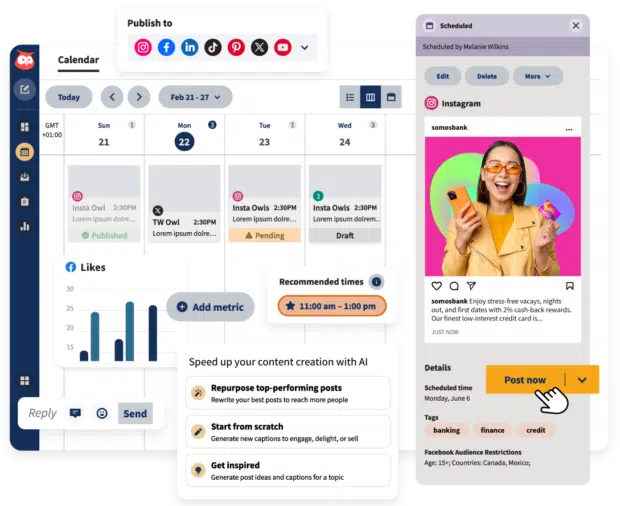
Want to see everything Hootsuite can do super quick? See it in action in under 2 minutes:
6. Analyze performance
Tracking your performance is more than charting views, followers, or engagement rates for vanity reasons. Analytics tell you what types of content your audience wants so you can do more of that, and less of what isn’t working. (And it allows you to update your manager and other stakeholders on what is working.)
For example, we recently experimented with videos on LinkedIn—a growing trend. We learned our LinkedIn audience loves educational videos, but most of our “TikTok-style” meme videos didn’t perform well on LinkedIn.
The opposite was true on TikTok: funny, relatable videos using trending sounds were the most popular, while our educational or product videos were the least popular. Analytics also told us both types of videos performed well on Instagram.
Without analytics reports, we may have guessed this info, but we wouldn’t have known for sure or been able to measure the difference trying new strategies made.
My favorite feature in Hootsuite Analytics is the ability to tag each post with a custom label. We tag our posts according to which of our three pillars they belong to, then pull analytics reports for each of those tags. That allows us to track performance by pillar and goal, as well as all the overall, built-in reports in Hootsuite Analytics.

I keep track of our metrics in a spreadsheet so the entire team can easily see how new strategies are impacting results.
Want this spreadsheet? Download our free social media audit template.

If you’re not seeing measurable results from social media planning yet, don’t worry. As my colleague Eileen Kwok points out:
Social media’s main purpose is as an awareness channel. Yes, we use it to bring in conversions but our larger goal is always making sure we’re spreading awareness of the company. We do that by being a community for social media managers first, and presenting our tool as a solution second.
Don’t be discouraged if your social media isn’t bringing in leads right away. That comes from potentially years of nurturing your audience.
7. Regularly update your content strategy
While this may sound like more of the “boring” stuff I mentioned earlier, setting a regular schedule for auditing your social media accounts is so crucial.
Without those insights, you won’t know what to test next, or what could be your next “go viral” moment.
Last year, we completed a detailed, per-post review which was well worth the time spent. We learned what works and what doesn’t by sorting posts into low, mid, and high performing categories. From there we were able to determine that for us animated infographics were a top performer, whereas animated product videos were not, among other insights.

This deep dive helped us take a look at what we were doing last year and tweak our strategy for the year ahead.
To make this easier, I recommend tracking key posts weekly or monthly rather than having to pull analytics for an entire year’s worth of content at once.
The elements to review to update your social media strategy include:
- Analyzing low, mid, and top performing content for patterns and trends.
- Analytics reports per platform and overall.
- Results of content tests.
- Social listening data, including what people are saying about you, brand sentiment over time, and what your competitors are doing.
- Comments and direct feedback on posts from your audience.
It’s all a cycle: post content, see how it performs, test new ideas, analyze some more, tweak, and repeat.
Get your social calendar started today with our free template.

Bonus: Here’s how often you should post to each social network for best results:
- Instagram: Post 2 times per week.
- Instagram Stories: Post 2 times per day.
- Facebook: Post 2 times per week.
- X (Twitter): Post 2 times per week
- LinkedIn: Post 2 times per week.
- Threads: Post between 2 to 3 times per day.
- TikTok: Post 14 times per week.
- Pinterest: Post at least 1 time per week.
1. You should post at least twice per week
You don’t need to post every day. While engagement vs. frequency varies by industry, organizations who post twice weekly had the highest overall engagement rate (2.08%) on Facebook:
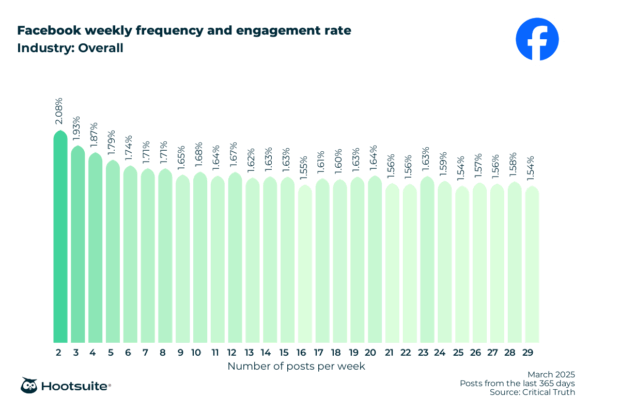
Our Instagram research had similar findings, with an engagement spike at two posts per week.

LinkedIn and X also showed the highest engagement with two posts per week. The outlier is TikTok where for the highest engagement rate, you should post 14 times per week.
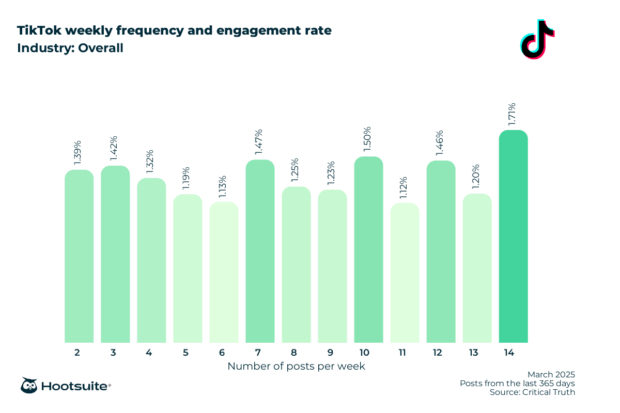
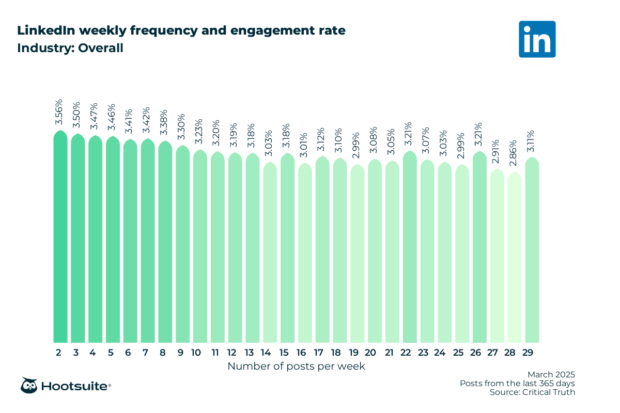

2. The best time to post on Facebook is 9 am
Our research shows that the optimal time to post on Facebook is 9 am Monday through Saturday.
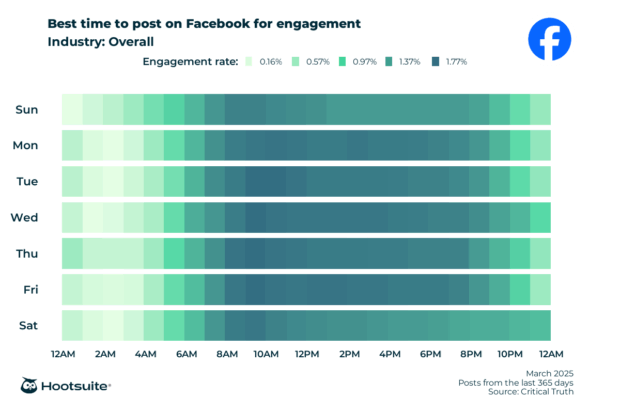
3. The best time to post on Instagram is 4 pm
For non-video posts, our research shows the best time to post on Instagram is 4 pm Tuesday through Saturday.
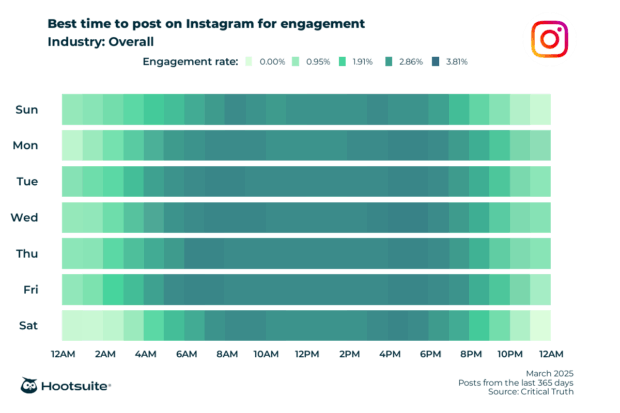
4. The best time to post on LinkedIn is 4-6 am
Our research shows the best time to post on LinkedIn is between 4-6 am on Tuesdays and 5-6 am on Fridays.
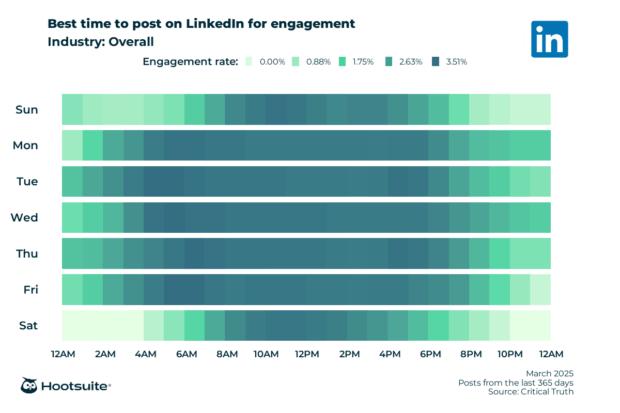
5. The best time to post on TikTok is 8 am
Our research has found the best time to post on TikTok is 8 am on Thursdays. Saturdays between 9 am-12 pm is the next best option.
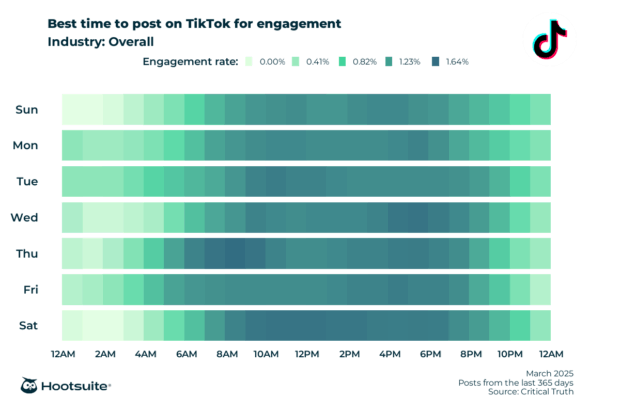
6. The best time to post on X (Twitter) is 9 am
Our research found X posts get the most engagement during business hours, with a peak between 9-11am on weekdays.

Social media calendar tools for 2025
You don’t need as many social media management tools as you think. Copy our stack below, or check out other social media calendar tools we recommend.
Hootsuite
Yep, of course the Hootsuite team uses Hootsuite for social media management. I covered how we use it and what it can do for you above, but basically, you can do everything you need to do for social media marketing for all your platforms, including:
- Planning, creating, and scheduling social media content, with an easy calendar view that includes all your channels.
- Answering DMs and comments from one unified inbox for all your profiles.
- Detailed analytics that show your actual social ROI, including for paid and organic content together.
- The world’s best social listening tools built-in to all plans.
- AI automations to save time with post drafting, inspiration, and more.
- 100+ integrations with all your other favorite tools.

Google Sheets
We use Google Sheets to audit and track our performance. Bonus: many of our free social media templates are set up for you in Google Sheets!
Wrike
We plan our social media content calendar in Wrike before scheduling posts in Hootsuite. Using a dedicated project management tool for this is helpful if you already use one to manage other work in your organization.
Miro
I love Miro’s open canvases for brainstorming and being able to connect with my team from anywhere.
CapCut
In my opinion, CapCut is one of the best video editing apps. We use it for TikTok editing and all our other social video content.
Once you’re ready to implement your social calendar, use Hootsuite for social media scheduling, audience engagement, best-in-class social listening, and meaningful analytics. Get your free trial today.








